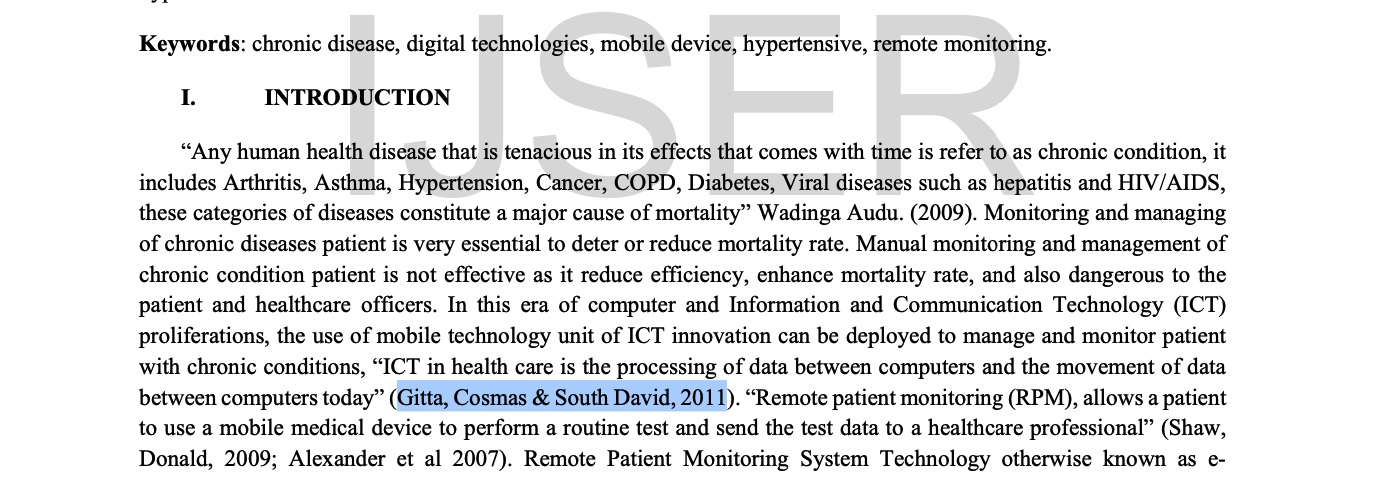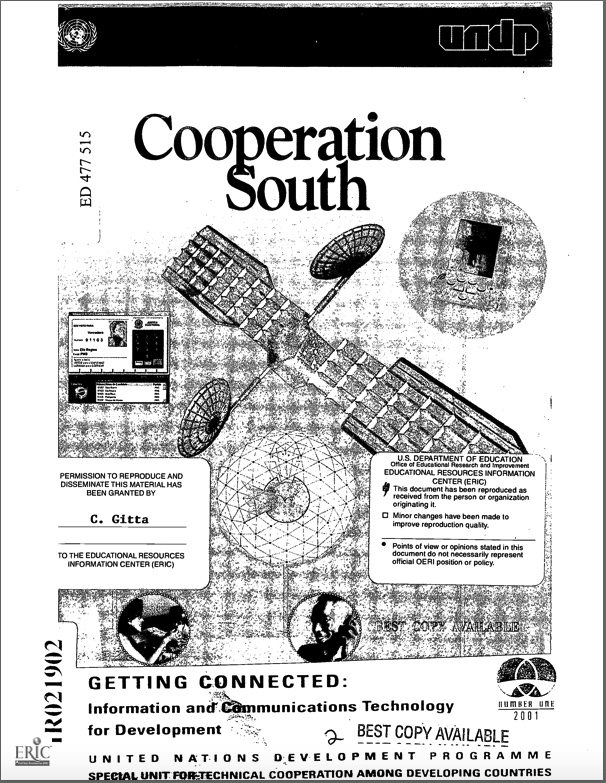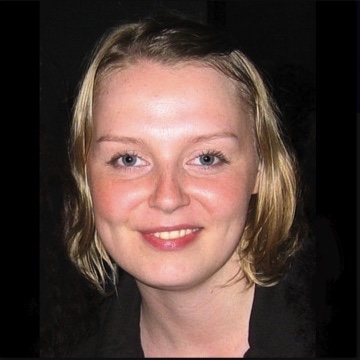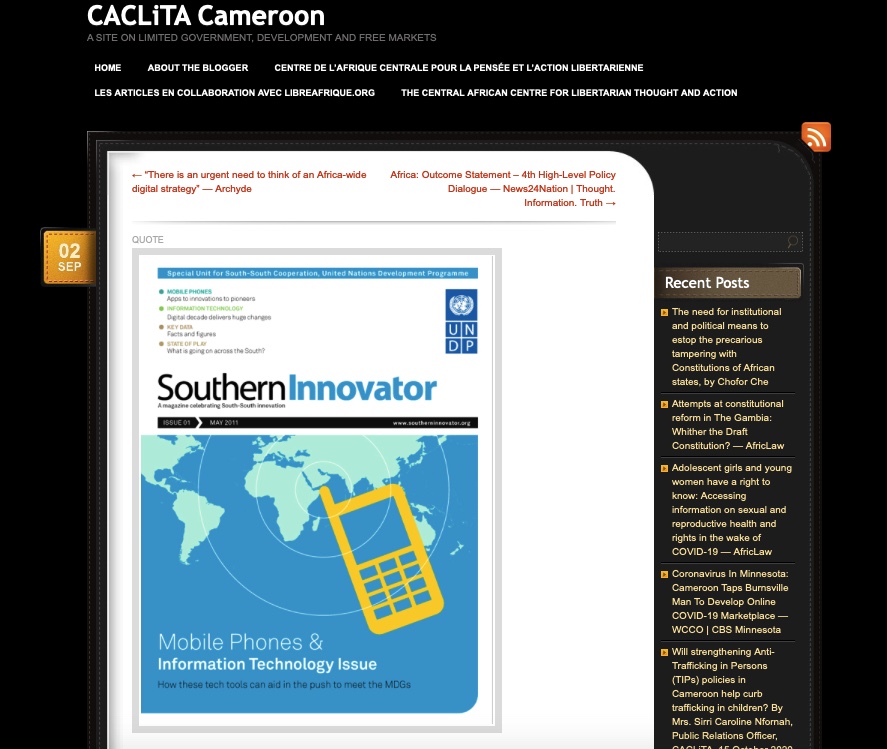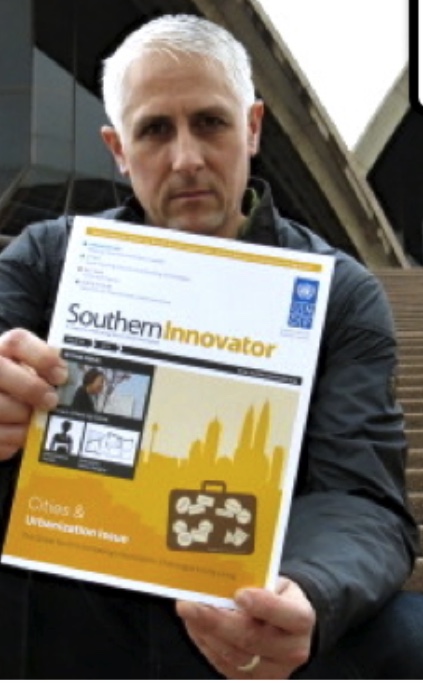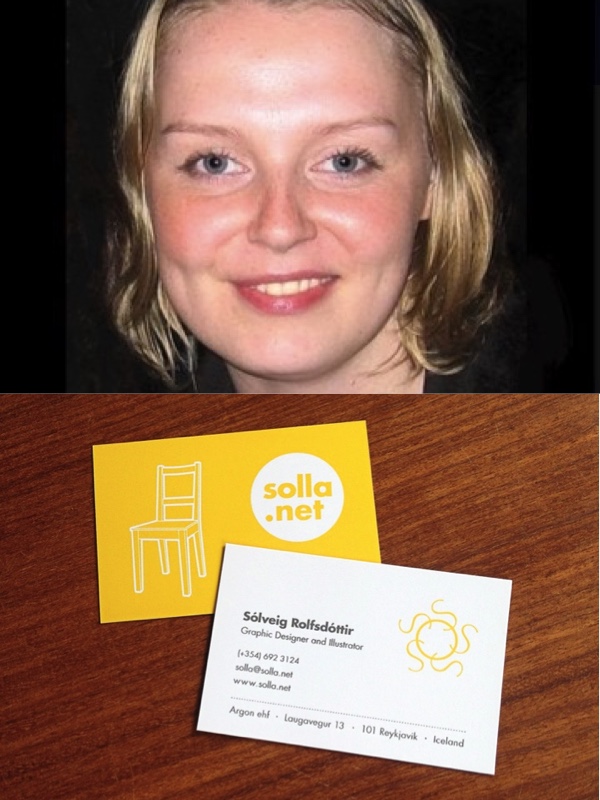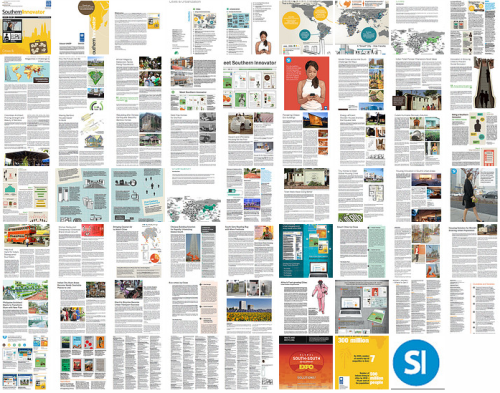Since 1997, David South Consulting (DSC) has been working in the international realm around health, human development and innovation. A number of significant and timely successes were able to leverage far greater change and inspire wider action. Some examples are below:
Southern Innovator 2011-2014
Beginning in 2007, DSC undertook work with the then Special Unit for South-South Cooperation (now the United Nations Office for South-South Cooperation - UNOSSC) within UNDP (the UN’s development organization). Through the e-newsletter Development Challenges, South-South Solutions (https://www.scribd.com/collections/2521424/Development-Challenges-South-South-Solutions-English), DSC was able to identify numerous trends that were at the time being overlooked or under-reported; trends that could radically re-shape international development. This included the rapid rise of mobile phones in the global South and their powerful impact on economic development, the rush to cities and urban areas that was turning the world into a majority urban place, and the shift to greater South-South trade, investment and contact. Whereas the past involved people always looking North for inspiration, capital and business and trade relationships, this was shifting to South-South arrangements. And there were plenty of inspirational, modern, 21st century examples of economic, social and human development achievements across the global South to report on. By consistently tracking and chronicling a quiet revolution underway in the global South, the e-newsletter was able to draw attention to a rising 21st-century global innovator culture being shaped by the use of mobile phones and information technologies. Few at the time had grasped how much this was going to reshape the international development paradigm.
To start, the e-newsletter Development Challenges, South-South Solutions (begun in 2006), was used to gather together as many stories, data, trends, and contacts as possible and get this message to as wide a group as possible. Luckily, this coincided with the very moment whole swathes of the global South were coming online, either through connecting with mobile phones or through the Internet. Quickly, it became clear there was not a lack of inspiring stories and innovations and solutions to share, but a lack of resources to communicate them. One solution was to utilise a new publishing tool that emerged in 2007: crowd-powered news services. It became a great way to bypass the stranglehold on news and information held by traditional media. Read more on this here: http://www.scribd.com/doc/251968773/Southern-Innovator-Summary-of-Impact-2011-to-2012
In particular, the e-newsletter caught the eye of those looking for inspiration in the wake of the 2007/2008 global economic crisis:
“Great economic and business reporting! Very helpful for us.” Africa Renewal, Africa Section, Strategic Communications Division, United Nations Department of Public Information
“I just went over your June newsletter. It’s very well done and far reaching. Congratulations!” Violette Ruppanner, Director, 3D -> Trade – Human Rights – Equitable Economy, Geneva, Switzerland
“Just to let you know I enjoyed the newsletter a lot – it was interesting to learn about things going on that I would never otherwise find out about, and also the listing of future conferences and events proved very useful.” Ian Sanderson, Deloitte, Geneva, Switzerland
“Congratulations on another great newsletter that’s packed with fascinating information! I really enjoy getting it each month.” Whitney Harrelson, Making Cents, Washington D.C.
In 2011, a new magazine, Southern Innovator was launched, using the insights gleaned from the e-newsletter. The first issue on mobile phones and information technology was called “a terrific tour de force of what is interesting, cutting edge and relevant in the global mobile/ICT space…”. A further four issues were published on different themes (and launched at global expos around the world), culminating in the United Nations Development Programme (UNDP) adopting innovation and South-South cooperation as its guiding approach in its new strategic plan for 2014 to 2017 (http://ssc.undp.org/content/dam/ssc/documents/Key%20Policy%20Documents/N1362177.pdf) (UNDP’s second ever). Southern Innovator was cited as one of the reasons for this. Issue 2 of Southern Innovator, on the theme of youth and entrepreneurship, was also cited as a resource in the first-ever UNDP Youth Strategy 2014-2017 (http://www.pnud.org.br/arquivos/Youth%20Strategy%202014-2017.pdf) (http://www.youthpolicy.org/library/wp-content/uploads/library/2014_UNDP_Youth_Strategy_Eng.pdf).
In 2013, the global Human Development Report took on the theme “The Rise of the South”: a theme first mooted as a potential cover story for Southern Innovator’s launch issue while in development in 2010 (http://www.davidsouthconsulting.com/blog/2015/7/27/you-heard-it-here-first-influencing-perspectives-on-the-glob.html).
In September 2015 (http://www.bbc.co.uk/news/world-asia-china-34372188), China's President Xi Jinping announced China would spend US $2 billion on South-South cooperation initiatives. This has been called “a ‘game changer’ in international relations” (http://www.ipsnews.net/2015/11/opinion-chinas-new-south-south-funds-a-global-game-changer/). President Xi also said of South-South cooperation, it is: “a great pioneering measure uniting the developing nations together for self-improvement, is featured by equality, mutual trust, mutual benefit, win-win result, solidarity and mutual assistance and can help developing nations pave a new path for development and prosperity.”
Southern Innovator has always tried to inspire others to take action and this has turned out to be the case.
"Beautiful, inspiring magazine from UNDP on South-South innovation. Heart is pumping adrenaline and admiration just reading it”
Once blazing a lonely trail, there are now many places to find stories on global South innovation (The Guardian, SciDev, Devex, Business Fights Poverty, Zunia etc.). Mainstream media have also woken up to the energy and change sweeping across the global South, disrupting its regular diet of negative news stories focused around war, disasters and failure (unfortunately, still the majority of what most people see on their TV).
"I liked your latest Southern innovator! Always inspiring.”
"Btw, I really enjoyed reading them, impressive work & a great resource. Looking forward to Issue 6. My best wishes to you & your team at SI.”
"The magazine looks fantastic, great content and a beautiful design!"
Most importantly, it is the young who have told us they ‘get’ Southern Innovator. It portrays a world they know - comfortable with new technologies, looking to solve problems, open to doing things in new ways. And it is that audience that excites us the most: the youth of the global South (Africa’s young population will be a huge contributor to the world's working-age workforce by 2050): they are shaping the new world we live in and seeking a role in it.
On Twitter, comments included: From @CapacityPlus Nice job RT @ActevisCGroup: RT @UNDP: Great looking informative @SouthSouth1 mag on South-South Innovation; @UNDP Great looking informative @SouthSouth1 mag on South-South Innovation; @JeannineLemaire Graphically beautiful & informative @UNDP Southern Innovator mag on South-South Innov.
The phases of this project have been compiled in two e-books and published online here:
Phase 1: https://books.google.co.uk/books?id=llSeBQAAQBAJ&printsec=frontcover&dq=editions:6eHzE10XqZIC&hl=en&sa=X&ved=0ahUKEwjSlZz3hv_KAhUDNhoKHetuA6EQ6AEIHDAA#v=onepage&q&f=false
Phase 2: https://books.google.co.uk/books?id=lK4jBgAAQBAJ&pg=PP4&dq=southern+innovator+compilation+of+documents&hl=en&sa=X&ved=0ahUKEwicqc3yhv_KAhVGPxoKHc5KC08Q6AEIHDAA#v=onepage&q=southern%20innovator%20compilation%20of%20documents&f=false
Phase 3: Scale-up Southern Innovator by seeking funding and support.
Citations
Autonomous Systems in the Intelligence Community: Many Possibilities and Challenges by Jenny R. Holzer, PhD, and Franklin L. Moses, PhD, Studies in Intelligence Vol 59, No. 1 (Extracts, March 2015)
Chile in Transition: Prospects and Challenges for Latin America's Forerunner of Development by Roland Benedikter and Katja Siepmann, Springer, 2015
Edible Insects and the Future of Food: A Foresight Scenario Exercise on Entomophagy and Global Food Security by Dominic Glover and Alexandra Sexton, Institute of Development Studies, King’s College London, Evidence Report No 149, September 2015
Export Now: Five Keys to Entering New Markets by Frank Lavin and Peter Cohan, John Wiley & Sons, 2011
High-level Committee on South-South Cooperation Seventeenth Session: Framework of operational guidelines on United Nations support to South-South and triangular cooperation: Note by the Secretary-General, 22-25 May 2012, New York
New Directions in Children’s and Adolescents’ Information Behavior Research edited by Dania Bilal and Jamshid Beheshti, Emerald Group Publishing, 2014
Recasting 'truisms' of low carbon technology cooperation through innovation systems: insights from the developing world by Alexandra Mallett, Innovation and Development, 5:2, 297-311, DOI: 10.1080/2157930X.2015.1049851, Routledge Taylor & Francis Group, 2015
A Sociological Approach to Health Determinants by Toni Schofield, Cambridge University Press, 2016
Strategic Framework of the United Nations Office for South-South Cooperation, 2014-2017, Executive Board of the United Nations Development Programme, the United Nations Population Fund and the United Nations Office for Project Services, 27 to 31 January 2014, New York
Wearing Your Map on Your Sleeve: Practices of Identification in the Creation and Consumption of Philippine Map T-shirts by Pamela Gloria Cajilig, paper presented at the 6th Global Conference (2014): Fashion: Exploring Critical Issues, Mansfield College, Oxford, United Kingdom, 15th to 18th September 2014
Youth Empowered as Catalysts for Sustainable Human Development: UNDP Youth Strategy 2014-2017, United Nations Development Programme, Bureau for Development Policy
 The first five issues of Southern Innovator from 2011 to 2014. Called a "Beautiful, inspiring magazine from UNDP on South-South innovation." GOSH Child Health Portal 2001-2003
The first five issues of Southern Innovator from 2011 to 2014. Called a "Beautiful, inspiring magazine from UNDP on South-South innovation." GOSH Child Health Portal 2001-2003
As the information technology revolution swept across the world, it was clear the UK had a lot of catching up to do. This was no more apparent than in its National Health Service (NHS). The Government at the time set about a Modernisation Plan for the NHS, based on widespread public consultation, with a significant component centered around communicating better. The Internet offered a great opportunity to rectify gaps in communication with patients, their families and professionals.
I was hired to lead a two-year project to radically transform access to online resources for the UK’s top children’s hospital and child health research institute. In order for this to effectively use the available resources, and to build public and professional confidence, a clear strategy was required, while the use of modern design was crucial to upgrading the brand image for the 21st century and maintaining relevance in the online age.
In order to do this, rapid prototyping was used to develop and test content and respond to users. At every stage of the project, each milestone was communicated, not only using in-house media but with the wider UK media.
The award-winning content was praised for its quality and how much it inspired others in the UK public and charity sector when developing their own online resources. The website drew praise for its content, design and accessibility.
Guardian: In 2003, the UK’s Guardian newspaper called the Children First website one of the “three most admired websites in the UK public and voluntary sectors.”
Cable and Wireless Childnet Award: Called Children First “an outstanding example of how a hospital can create quality, authoritative information on issues relating to health in a fun, child-centered and accessible way.”
The Times: In 2006, The Times of London called Children First the Top Child Health Website in its Wellbeing on the Web: The Best Portals survey (November 11, 2006).
Prime Minister Tony Blair: “Making sure that your child has helpful, easy-to-read information will make a significant difference to their time in hospital. I am sure that this website will prove very useful for children and their families.”
UK Government:
The project’s three phases can be reviewed online here:
Phase 1: http://www.scribd.com/doc/47241951/GOSH-Child-Health-Portal-Project-Phase-1a
Phase 2: http://www.scribd.com/doc/47242473/GOSH-Child-Health-Portal-Project-Phase-2a
Phase 3: http://www.scribd.com/doc/47242267/GOSH-Child-Health-Portal-Project-Phase-3
Citations
GOSH Child Health Portal Phase 1a by David South, 2003
GOSH Child Health Portal Phase 1b by David South, 2003
GOSH Child Health Portal Phase 2a by David South, 2003
GOSH Child Health Portal Phase 2b by David South, 2003
GOSH Child Health Portal Phase 3 by David South, 2003
GOSH Project Launch Brochure and Screen Grabs, 2001-2003 by David South, 2003
The Great Ormond Street Hospital Manual of Children's Nursing Practices by Susan Macqueen, Elizabeth Bruce and Faith Gibson, John Wiley & Sons, 2012
Help! My Child's in Hospital by Becky Wauchope, Marbec Family Trust, 2012
Oxford Desk Reference: Nephrology by Jonathan Barratt, Peter Topham and Kevin P. G. Harris, Oxford University Press, 2008
Research Review 2001: A Year of Excellence and Innovation, Institute of Child Health and Great Ormond Street Hospital for Children NHS Trust, 2001

Research Review 2002: Building on Success, Institute of Child Health and Great Ormond Street Hospital for Children NHS Trust, 2002

UNDP Mongolia Communications Office 1997-1999
As Head of Communications for the UN mission in Mongolia during a major crisis (1997 to 1999) (called at the time the largest post-WWII, peacetime economic collapse) (Pomfret 2000)*, I was able to use a clear strategy to transform access to information and resources on the country’s development. By quickly embracing the newly emerging benefits of Internet technology, the mission was able to communicate what it was doing in a timely fashion, and become a source for the latest updates on Mongolia’s development challenges, not only to the wider global development community but also to international and Mongolian media. By being transparent in the face of a crisis, hundreds of stories were followed up on by the media. A sample of stories were eventually published in the UN book In Their Own Words: Selected Writings by Journalists on Mongolia, 1997-1999 (ISBN 99929-5-043-9).
In order to bring greater focus to the rapidly growing UN mission and also to better meet Mongolia’s needs in a major crisis, a Communications Office was established and a highly talented team assembled. The Office acted as a strategic hub to lead on communicating and meeting Mongolia’s crisis needs while also serving as a role model and champion for publishing and design, including for the Internet. As an example, an ad by the Office regularly ran in local media declaring the Office was “Where the Steppe Meets the Internet” (www.un-mongolia.mn).
The UN conducted a global survey in 2000 and placed the award-winning website launched and overseen by the Office as third-best in the world and had this to say: “A UN System site. A very nice, complete, professional site. Lots of information, easily accessible and well laid out. The information is comprehensive and up-to-date. This is a model of what a UNDP CO web site should be.”
UN Mongolia Annual Report (1998), editor and designer. Called by Under-Secretary-General Nafis Sadik “a clear, well-written, attractive and colourful report.”
In 2001, the UN was awarded the Nobel Peace Prize for “their work for a better organized and more peaceful world”. Communications achievements, such as above, were cited as a reason for the Prize.
The work has also been documented in numerous works of journalism, academic papers and books, including Wild East: Travels in the New Mongolia (ISBN 1459645782, 9781459645783) and Modern Mongolia: From Khans to Commissars to Capitalists (ISBN 0520938623, 9780520938625).
Proof, if there ever was, that transparency and a clear strategy in a crisis will pay off dividends in the end. Don’t fear getting the message out but do it with a clear idea of what your objectives are.
*Transition and Democracy in Mongolia by Richard Pomfret, Europe-Asia Studies, Vol. 52, No. 1 (Jan., 2000), pp. 149-160, published by Taylor & Francis, Ltd. (http://www.jstor.org/stable/153756?seq=1#page_scan_tab_contents)
Citations
Dateline Mongolia: An American Journalist in Nomad’s Land by Michael Kohn, RDR Books, 2006, ISBN 1-57143-155-1
The Devil and the Disappearing Sea: A True Story About the Aral Sea Catastrophe by Robert Ferguson, Raincoast Books, 2003, ISBN 1-55192-599-0
The Horse-head Fiddle and the Cosmopolitan Reimagination of Mongolia by Peter K. Marsh, Taylor and Francis, 2008, ISBN 041597156X, 9780415971560
Modern Mongolia: From Khans to Commissars to Capitalists by Morris Rossabi, University of California Press, 2005, ISBN 0-520-24399-4
Mongolian Rock and Pop: In Our Own Voice (in Mongolian), ISBN 99929-5-018-8
Wild East: Travels in the New Mongolia by Jill Lawless, ECW Press, 2000, ISBN 1-55022-434-4 (www.wildeast.ca)
Blue Sky Bulletin
Bounty from the Sheep: Autobiography of a Herdsman by Tserendashiin Namkhainiambuu, Inner Asia Book Series, White Horse, 2000
Modern Mongolia: From Khans to Commissars to Capitalists by Morris Rossabi, University of California Press, 2005
Mongols from Country to City: Floating Boundaries, Pastoralism and City Life in the Mongol Lands edited by Ole Bruun and Li Narangoa, Issue 34 of NIAS Studies in Asian Topics, Nordisk Institut for Asienstudier, NIAS Press, 2006
Ger Magazine
A Complete Guide on Celebrations, Festivals and Holidays around the World by Sarah Whelan, Asteroid Content, 2015
Gale Directory of Publications and Broadcast Media by Jeff Summer, Gale Group, 2001
Mongol Survey, Issue 8, The Society, 2001
Mongolian Culture and Society in the Age of Globalization by Henry G. Schwarz (editor), Center for East Asian Studies, Western Washington University, 2006
Nations in Transition: Mongolia by Jennifer L. Hanson, Infobase Publishing, 2003
Teen Life in Asia by Judith J. Slater, Greenwood Publishing Group, 2004
World Press Encyclopedia: A Survey of Press Systems Worldwide, Volume 1 by Amanda C. Quick, Gale Group, 2003
Human Development Report Mongolia 1997
Change in Democratic Mongolia: Social Relations, Health, Mobile Pastoralism, and Mining, 2012
Curbing Corruption in Asian Countries: An Impossible Dream? by Jon S. T. Quah, Emerald Group Publishing, 2011
Diseases of Globalization: Socioeconomic Transition and Health by Christine McMurray and Roy Smith, Routledge, 2013
Economic Institutions and Democratic Reform: A Comparative Analysis of Post-communist Countries by Ole Norgaard, Edward Elgar Publishing, 2000
Educational Import: Local Encounters with Global Forces in Mongolia by Gita Steiner-Khamsi and Ines Stolpe, Palgrave Macmillan, 2006
Group Behaviour and Development: Is the Market Destroying Cooperation? by Judith Heyer, Frances Stewart, Rosemary Thorp, OUP Oxford, 2002
Higher Education in the Developing World: Changing Contexts and Institutional Responses by David W. Chapman and Ann E. Austin, Greenwood Publishing Group, 2002
Modern Mongolia: From Khans to Commissars to Capitalists by Morris Rossabi, University of California Press, 2005
Precious Steppe: Mongolian Nomadic Pastoralists in Pursuit of the Market by Ole Bruun, Lexington Books, 2008
Rethinking Development in East Asia: From Illusory Miracle to Economic Crisis by Pietro Masina, Routledge, 2012
Mongolia Update 1998
Bounty from the Sheep: Autobiography of a Herdsman by Tserendashiin Namkhainiambuu, Inner Asia Book Series, White Horse, 2000
Selection and Preparation of Australian Expatriates and Business People for Postings in Mongolia by Gantsetseg O’Brien and Greg Trotman, Department of Marketing, International Business and Tourism, University of the Sunshine Coast, Australia, Working Paper 99/3, December 1999. Website: http://research.usc.edu.au/vital/access/manager/Repository/usc:2914
Semi-Presidentialism Outside Europe: A Comparative Study edited by Robert Elgie and Sophia Moestrup, Routledge, 2007
Transition and Democracy in Mongolia by Richard Pomfret, Europe-Asia Studies, Vol. 52, No. 1, 2000, 149-160. Website: http://www.jstor.org/pss/153756
www.un-mongolia.mn
Asian Perspective, Volume 25, Insitute for Far Eastern Studies, Kyung Nam University, 2001
Modern Mongolia: Reclaiming Genghis Khan, An Exhibit of the University of Pennsylvania Museum of Archaeology and Anthropology
Rethinking Development in East Asia: From Illusory Miracle to Economic Crisis by Pietro Masina, Routledge, 2012
Tulsa Journal of Comparative & International Law, Volume 7, 1999




This work is licensed under a
Creative Commons Attribution-Noncommercial-No Derivative Works 3.0 License.
 Monday, April 6, 2020 at 3:18AM
Monday, April 6, 2020 at 3:18AM 
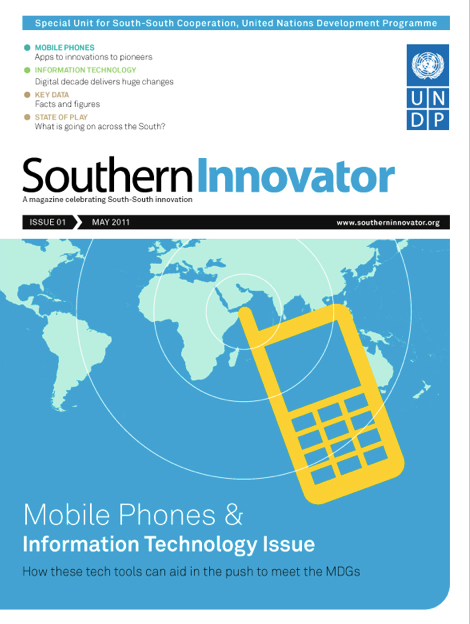 Southern Innovator Issue 1: Mobile Phones and Information Technology.
Southern Innovator Issue 1: Mobile Phones and Information Technology. 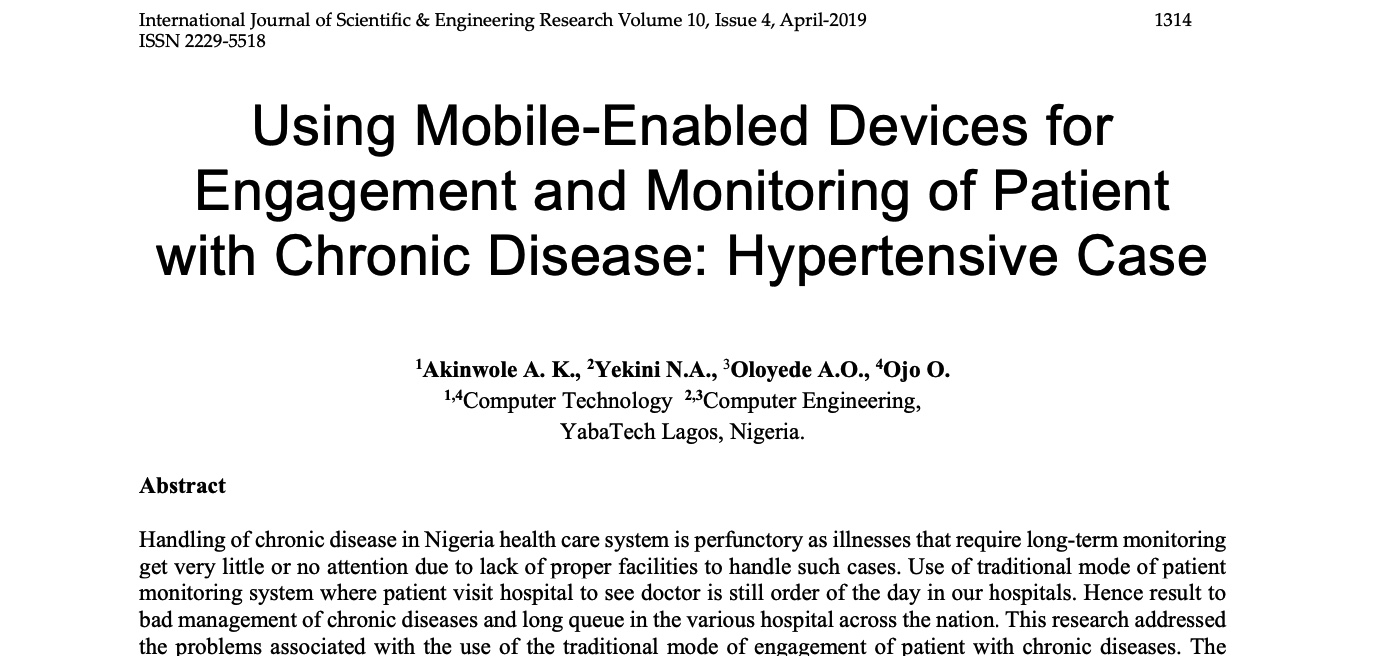 Citation in Using Mobile-Enabled Devices for Engagement and Monitoring of Patient with Chronic Disease: Hypertensive Case in the International Journal of Scientific & Engineering Research Volume 10, Issue 4, April 2019 (ISSN 2229-5518).
Citation in Using Mobile-Enabled Devices for Engagement and Monitoring of Patient with Chronic Disease: Hypertensive Case in the International Journal of Scientific & Engineering Research Volume 10, Issue 4, April 2019 (ISSN 2229-5518).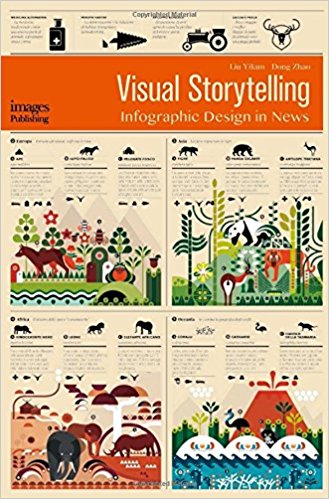 Visual Storytelling: Infographic Design in News published by Images Publishing.
Visual Storytelling: Infographic Design in News published by Images Publishing.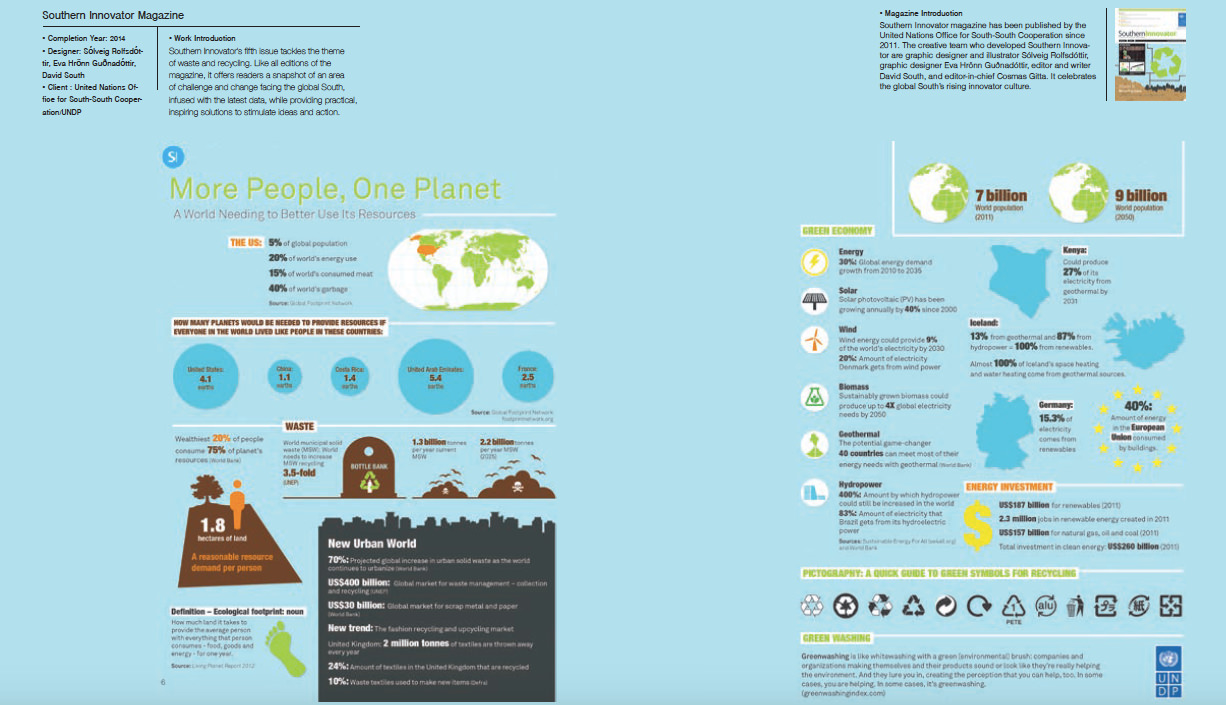 The proof flats for inclusion in Visual Storytelling: Infographic Design in News.
The proof flats for inclusion in Visual Storytelling: Infographic Design in News.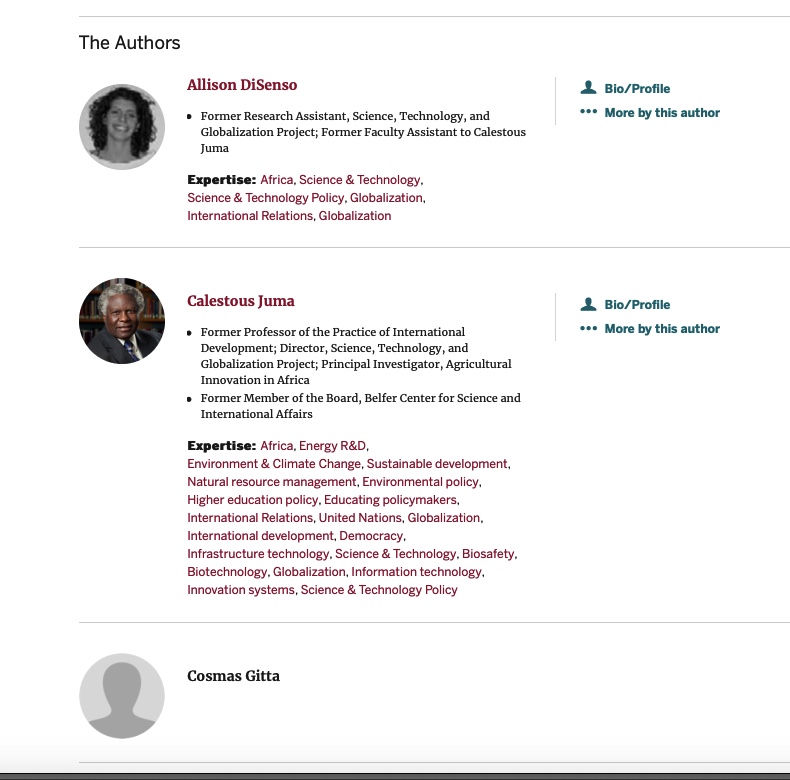 The authors: Forging New Technology Alliances: The Role of South-South Cooperation Juma, Calestous, Cosmas Gitta, Allison Disenso, and Audette Bruce. Cooperation South Journal (2005).
The authors: Forging New Technology Alliances: The Role of South-South Cooperation Juma, Calestous, Cosmas Gitta, Allison Disenso, and Audette Bruce. Cooperation South Journal (2005). Getting Connected: Information and Communications Technology for Development (2001).
Getting Connected: Information and Communications Technology for Development (2001).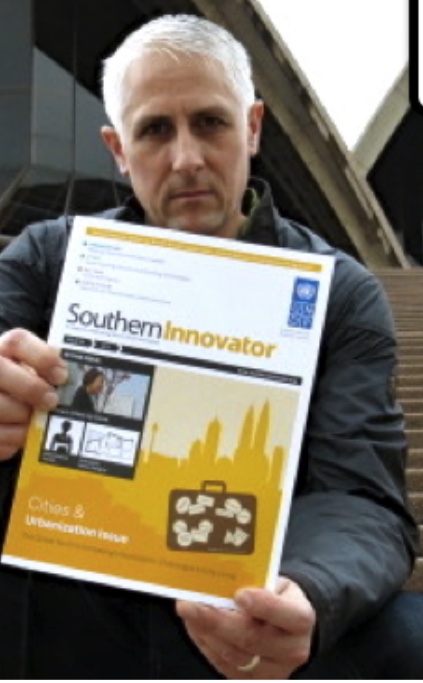 David South, Editor and Writer: David South is the founder and senior partner for David South International and David South Consulting. He has worked around the world for the United Nations and has led a number of groundbreaking projects for major institutions. Clients have included the United Nations Office for South-South Cooperation (UNOSSC), the United Nations Development Programme (UNDP), the Great Ormond Street Hospital for Children (GOSH)/Institute of Child Health (ICH)/National Health Service (NHS), Harvard Institute for International Development, UNICEF, World Bank, USAID, and the Hannah Institute for the History of Medicine, among others.
David South, Editor and Writer: David South is the founder and senior partner for David South International and David South Consulting. He has worked around the world for the United Nations and has led a number of groundbreaking projects for major institutions. Clients have included the United Nations Office for South-South Cooperation (UNOSSC), the United Nations Development Programme (UNDP), the Great Ormond Street Hospital for Children (GOSH)/Institute of Child Health (ICH)/National Health Service (NHS), Harvard Institute for International Development, UNICEF, World Bank, USAID, and the Hannah Institute for the History of Medicine, among others.


 David South
David South
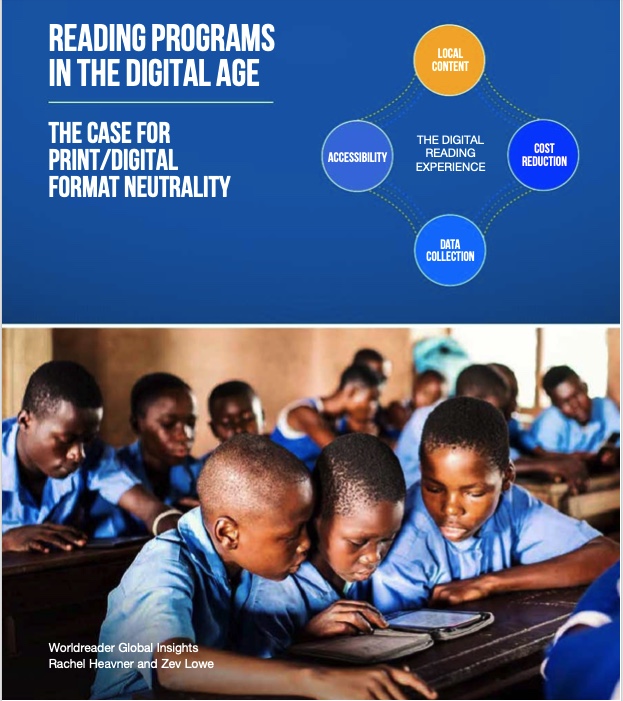 Reading Programs in the Digital Age: The Case for Print/Digital Format Neutrality (Worldreader Global Insights: 2017).
Reading Programs in the Digital Age: The Case for Print/Digital Format Neutrality (Worldreader Global Insights: 2017). David South | Comments Off |
David South | Comments Off |  Cosmas Gitta,
Cosmas Gitta,  David South,
David South,  International Journal of Scientific & Engineering Research,
International Journal of Scientific & Engineering Research,  Southern Innovator,
Southern Innovator,  UNDP,
UNDP,  UNOSSC,
UNOSSC,  United Nations,
United Nations,  citations,
citations,  global South,
global South,  mobile phones,
mobile phones,  mobile phones and information technology,
mobile phones and information technology,  mobile-enabled devices in
mobile-enabled devices in  21st century,
21st century,  Cosmas Gitta,
Cosmas Gitta,  Crisis Response Media,
Crisis Response Media,  David South Consulting,
David South Consulting,  Digital,
Digital,  Global South,
Global South,  Health and Human Development,
Health and Human Development,  Human Development Innovator,
Human Development Innovator,  ICT4D,
ICT4D,  International Development,
International Development,  Knowledge Sharing,
Knowledge Sharing,  Media,
Media,  Millennium Development Goals,
Millennium Development Goals,  Mobile Phones and Information Technology,
Mobile Phones and Information Technology,  Mobiles,
Mobiles,  Reverse engineering,
Reverse engineering,  Southern Innovator,
Southern Innovator,  Sustainable Development Goals,
Sustainable Development Goals,  UNOSSC,
UNOSSC,  United Nations,
United Nations,  Youth
Youth 